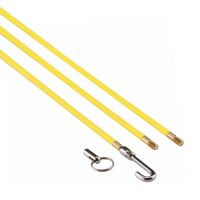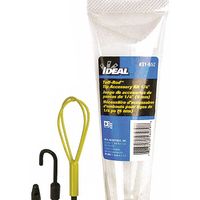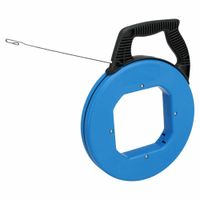Call +(254) 703 030 000 / 751 483 999 / 721 704 777
- Home
- Tools
- Hand Tools
- Electrical Data Hand Tools
- Wire Cable Pullers
.....Read More
Frequently Asked Questions
What is a wire and cable puller used for?
A wire and cable puller is a tool or device used to facilitate the installation of electrical wires and cables through conduits, ducts, or other pathways. It is essential in various construction, electrical, and telecommunications projects where cables need to be routed over long distances or through complex pathways.
The primary function of a wire and cable puller is to provide the necessary force to pull cables through these pathways without causing damage to the cables or the surrounding infrastructure. This is particularly important when dealing with heavy or long cables that would be difficult to pull manually.
Wire and cable pullers come in various forms, including manual, mechanical, and powered versions. Manual pullers often use a hand-crank mechanism, while mechanical pullers might use gears or levers to amplify pulling force. Powered pullers, which are more common in large-scale projects, use electric or hydraulic motors to provide significant pulling power.
These tools are equipped with features like adjustable pulling speeds, tension control, and safety mechanisms to prevent over-pulling, which can damage cables. They often include attachments or accessories such as pulling grips, swivels, and rollers to accommodate different cable types and sizes, ensuring a secure grip and smooth pulling process.
In summary, wire and cable pullers are crucial for efficiently and safely installing cables in various settings, reducing labor intensity, minimizing the risk of cable damage, and ensuring compliance with installation standards.
How do you use a fish tape to pull wire?
To use a fish tape to pull wire, follow these steps:
1. **Preparation**: Turn off power to the area where you’ll be working. Identify the start and end points for the wire run. Remove any necessary wall plates or access panels.
2. **Insert Fish Tape**: Unwind the fish tape from its reel. Insert the end of the fish tape into the conduit or wall opening at the starting point. Push the tape through the conduit or wall cavity towards the destination. Keep the tape straight to avoid kinks.
3. **Guide the Tape**: As you push, guide the tape through bends and turns. If resistance is met, gently wiggle or rotate the tape to navigate obstacles. Use a flashlight to help see inside the conduit if needed.
4. **Reach the Destination**: Once the tape reaches the destination, have a helper notify you or listen for the tape end. Pull out enough tape to attach the wire.
5. **Attach the Wire**: Strip the insulation from the end of the wire. Use electrical tape to securely attach the wire to the fish tape’s loop or hook. Ensure the connection is smooth to prevent snags.
6. **Pull the Wire**: Return to the starting point. Slowly and steadily pull the fish tape back through the conduit, drawing the wire along. Have a helper feed the wire to prevent tangles.
7. **Complete the Pull**: Once the wire is through, detach it from the fish tape. Inspect the wire for damage. Rewind the fish tape onto its reel.
8. **Finish Up**: Connect the wire to its terminals or devices. Replace any wall plates or panels. Restore power and test the installation.
By following these steps, you can effectively use a fish tape to pull wire through conduits or wall cavities.
What are fish sticks and glow rods used for?
Fish sticks and glow rods are tools commonly used in electrical work and cable installation to facilitate the routing and pulling of wires through walls, ceilings, and other confined spaces.
Fish Sticks:
Fish sticks, also known as fish tapes or wire pullers, are flexible, elongated tools designed to help electricians and installers guide wires through difficult-to-reach areas. They are typically made of fiberglass or a similar material, providing the necessary flexibility and strength to navigate through tight spaces without breaking. Fish sticks come in various lengths and can be connected to extend their reach. They are used to "fish" wires through walls, conduit, or other pathways, making it easier to pull cables from one point to another without having to open up large sections of the structure.
Glow Rods:
Glow rods are a type of fish stick that have the added feature of being luminescent or glow-in-the-dark. This feature is particularly useful in low-light or dark environments, such as attics, basements, or inside walls, where visibility is limited. The glow-in-the-dark property helps installers see the rod's position, making it easier to guide and retrieve. Like standard fish sticks, glow rods are made of durable materials like fiberglass and can be connected to extend their length. They are used in similar applications, aiding in the installation of electrical wiring, network cables, and other types of cabling.
Both fish sticks and glow rods are essential tools for electricians and cable installers, improving efficiency and safety by reducing the need for extensive structural modifications during wire installation.
How do you choose the right fish tape length?
To choose the right fish tape length, consider the following factors:
1. **Project Scope**: Determine the distance the fish tape needs to cover. Measure the length of the conduit or pathway where the wire will be pulled. For typical residential projects, a 25 to 50-foot fish tape is often sufficient. For larger commercial or industrial projects, you might need 100 feet or more.
2. **Conduit Complexity**: Assess the complexity of the conduit system. Longer fish tapes are beneficial for navigating through multiple bends and turns. If the conduit has many curves or is particularly intricate, a longer tape provides more flexibility and reach.
3. **Accessibility**: Consider the accessibility of the starting and ending points. If the entry and exit points are easily accessible, a shorter fish tape might suffice. However, if you need to navigate through walls, ceilings, or floors, a longer tape may be necessary.
4. **Material and Flexibility**: Choose a fish tape material that suits the environment. Steel fish tapes are durable and suitable for straight runs, while fiberglass or nylon tapes are more flexible and ideal for navigating bends and avoiding electrical interference.
5. **Future Needs**: Anticipate future projects. If you frequently work on various projects, investing in a longer fish tape can be more economical and versatile for different scenarios.
6. **Storage and Portability**: Consider the ease of storage and transport. Longer fish tapes can be bulkier and heavier, so ensure you have adequate storage space and can handle the weight during use.
By evaluating these factors, you can select a fish tape length that meets your current needs while providing flexibility for future projects.
What is the difference between fish tape and conduit rodder?
Fish tape and conduit rodder are both tools used for pulling wires through conduits, but they have distinct differences:
1. **Material and Construction**:
- **Fish Tape**: Typically made of a thin, flexible steel or fiberglass tape wound on a reel. It is designed to be lightweight and easy to handle, making it suitable for shorter runs and less complex conduit systems.
- **Conduit Rodder**: Constructed from more rigid materials like fiberglass rods, often encased in a protective sheath. It is designed for durability and can handle longer distances and more challenging conduit paths.
2. **Flexibility and Strength**:
- **Fish Tape**: Offers greater flexibility, allowing it to navigate through tight bends and curves in conduits. However, it may not be as strong or durable for heavy-duty applications.
- **Conduit Rodder**: Provides more strength and rigidity, making it suitable for pushing through longer and straighter conduit runs. It can handle more force without bending or breaking.
3. **Applications**:
- **Fish Tape**: Ideal for residential or light commercial applications where the conduit runs are relatively short and have multiple bends.
- **Conduit Rodder**: Best suited for industrial or large commercial projects where conduits are longer, straighter, and may require more force to navigate.
4. **Ease of Use**:
- **Fish Tape**: Easier to use for beginners due to its flexibility and lightweight nature. It is more maneuverable in confined spaces.
- **Conduit Rodder**: Requires more skill and effort to use effectively, especially in complex conduit systems, but offers superior performance in demanding situations.
5. **Cost**:
- **Fish Tape**: Generally less expensive, making it a cost-effective choice for smaller projects.
- **Conduit Rodder**: More costly due to its robust construction and suitability for heavy-duty tasks.
How do you use a magnetic retriever for wire installation?
To use a magnetic retriever for wire installation, follow these steps:
1. **Preparation**: Identify the path where the wire needs to be installed. Ensure the area is clear of obstructions and that you have access to both ends of the path.
2. **Attach the Magnet**: Securely attach the magnet to the end of the wire or cable you wish to install. This is typically done using a small, strong magnet that can be tied or clipped onto the wire.
3. **Insert the Wire**: Begin feeding the wire into the starting point of the installation path. This could be a conduit, wall cavity, or any other enclosed space.
4. **Use the Retriever Tool**: On the opposite end of the path, use the magnetic retriever tool. This tool usually consists of a long, flexible rod with a magnet at the end.
5. **Guide the Wire**: Insert the retriever tool into the path and move it towards the wire. The magnet on the retriever will attract the magnet attached to the wire, allowing you to guide the wire through the path.
6. **Pull the Wire Through**: Once the magnets connect, gently pull the retriever tool back, bringing the wire along with it. Ensure the wire moves smoothly and does not snag on any obstacles.
7. **Complete the Installation**: Once the wire is pulled through to the desired endpoint, detach the magnet and proceed with securing the wire as needed for your installation.
8. **Check the Installation**: Verify that the wire is correctly positioned and that there are no kinks or damage. Make any necessary adjustments.
This method is particularly useful for running wires through difficult-to-access areas, such as behind walls or through tight conduits.
What safety precautions should be taken when using wire and cable pullers?
1. **Inspect Equipment**: Before use, check the wire and cable pullers for any signs of wear, damage, or defects. Ensure all components are in good working condition.
2. **Read the Manual**: Familiarize yourself with the manufacturer's instructions and safety guidelines specific to the equipment being used.
3. **Wear Protective Gear**: Use appropriate personal protective equipment (PPE) such as gloves, safety glasses, hard hats, and steel-toed boots to protect against potential hazards.
4. **Check the Environment**: Ensure the work area is clear of obstacles, debris, and any potential tripping hazards. Make sure the ground is stable and dry to prevent slips and falls.
5. **Use Proper Techniques**: Employ correct lifting and pulling techniques to avoid strain or injury. Use your legs, not your back, when lifting heavy objects.
6. **Secure the Load**: Ensure that the wire or cable is securely attached to the puller and that all connections are tight to prevent slippage.
7. **Monitor Tension**: Be aware of the tension on the wire or cable to avoid overloading the puller, which could lead to equipment failure or accidents.
8. **Communicate Clearly**: Maintain clear communication with team members to coordinate movements and ensure everyone is aware of the operation.
9. **Stay Alert**: Be vigilant and attentive to your surroundings and the task at hand to quickly respond to any unexpected situations.
10. **Emergency Procedures**: Be familiar with emergency shutdown procedures and have a plan in place for dealing with accidents or equipment malfunctions.
11. **Regular Maintenance**: Perform regular maintenance on the pullers to ensure they remain in safe working condition.
12. **Training**: Ensure all operators are properly trained and competent in using the equipment safely.



